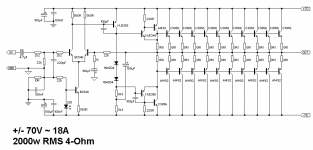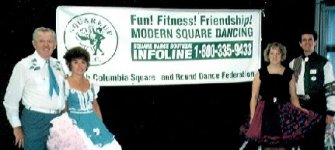Unless you plan to bridge it can't see how you would get 2000 W into 4 Ohms. More like 500 it seems with those rails.
/UrSv
/UrSv
soo who can i get 2000W ?
it is a 20 Transistors of 200W ani one
i need to us in bigger power supply?
it is a 20 Transistors of 200W ani one
i need to us in bigger power supply?
And what is the sensitivity of your
speakers in dB SPL /watt?
And how many 1000 meters from the speakers
will people dance?
speakers in dB SPL /watt?
And how many 1000 meters from the speakers
will people dance?
With a +/- 70V supply, a sine wave can swing over a 140V amplitude (assuming no losses whatsoever). The RMS voltage of such a sine wave is 70/sqrt(2) ~ 50 Volts.
Power = Voltage^2/load = 2500/4 = 625 Watt.
Please don't tell me that max. square wave power is higher (this indeed is 1250 W); nobody listens or dances to square waves 🙂
Regards,
Dirk
Power = Voltage^2/load = 2500/4 = 625 Watt.
Please don't tell me that max. square wave power is higher (this indeed is 1250 W); nobody listens or dances to square waves 🙂
Regards,
Dirk
Let's do some Square-Dancing!
You have never heard of Square Dance?
😀
SquareDance.bc.ca
😀 Soooo?Dirk said:.... nobody listens or dances to square waves 🙂
Regards,
Dirk
You have never heard of Square Dance?
😀
SquareDance.bc.ca
I had already heard that Swedes had problems staying sober during the dark season, but I didn't know it was that bad 😀
Dirk
Dirk
Dj BASS AMP said:So whow can i get 2000W ?
Do i need to use a bigger power supply?
If you parallell two 4 ohms speakers, you get 2 ohms.
For to put 2000W out,
you need 90 Volt peak, that is 45 Ampere peak. (90volt/2 ohms)
So your Power supply need plus/minus 100 Volt
And a lot of Ampere.
Trafo should be 2x70 volt 15-30 Ampere, Minimum!
Two 70 volts 15 Ampere or more = (Two >=1000 VA)
 Always remember that Amplifier can not give power.
Always remember that Amplifier can not give power.It is Trafo and power supply that gives power!
See what Nelson recommends.
He want good BIG power supplies, because he knows! 😉
DJ,
Please bear in mind that Rod's amp has no current limiting, so if a short is placed across the ouput its output stage will be destroyed. A design with short circuit protection, like the Leach amp or (I think) one of Anthony Holton's designs, is preferred for PA use.
In a live sound / DJ situation, its not so much _if_ an amp will be driven into a short, more like _when_ it will be driven into a short!
Tim.
Please bear in mind that Rod's amp has no current limiting, so if a short is placed across the ouput its output stage will be destroyed. A design with short circuit protection, like the Leach amp or (I think) one of Anthony Holton's designs, is preferred for PA use.
In a live sound / DJ situation, its not so much _if_ an amp will be driven into a short, more like _when_ it will be driven into a short!
Tim.
What you really need to do is build one of these.
Then you really will have the biggest on the block.
http://gilmore.chem.northwestern.edu/page1.gif
http://gilmore.chem.northwestern.edu/page2.gif
Then you really will have the biggest on the block.
http://gilmore.chem.northwestern.edu/page1.gif
http://gilmore.chem.northwestern.edu/page2.gif
One trick that worl well is just building something like four amps and making them drive 1 speaker each this will give much more spl than one more powerful amp for all the speaker.
Loud Loud Loud with Very Little Power
In this regard, I found this thread quite inspiring.
JBL said:One trick that works well is just building something like four amps and making them drive 1 speaker each this will give much more spl than one more powerful amp for all the speaker.
In this regard, I found this thread quite inspiring.
DJ,
Your amp will not work as it is. Assuming the led is an ordinary red led (not high efficiency led) the total current in the differential pair is abt 1 mA. That is 0.5 mA for each transistor.
In order to obtain correct biasing for the following transistor MJE350, you have to modify the resistors inserted in the collector of each BC557, 1.2 kohm is the right value.
If you use green led, the right value may be different. Il all cases the dc current must be the same in each of the two BC557, and the base of the MJE350 must be biased at abt 0.6 V.
To prevent HF oscillations, it seems to be necessary to add some filtering in the supply rails between the input / driver stages, and the finals. Also, add a little resistor (47 ohms) in series in emitter connexion of each of the BC557 in the differential pair. Or use 100 ohms variable resistor with center tap : so you can cancel the offset of the amplifier.
Regards, Pierre Lacombe.
Your amp will not work as it is. Assuming the led is an ordinary red led (not high efficiency led) the total current in the differential pair is abt 1 mA. That is 0.5 mA for each transistor.
In order to obtain correct biasing for the following transistor MJE350, you have to modify the resistors inserted in the collector of each BC557, 1.2 kohm is the right value.
If you use green led, the right value may be different. Il all cases the dc current must be the same in each of the two BC557, and the base of the MJE350 must be biased at abt 0.6 V.
To prevent HF oscillations, it seems to be necessary to add some filtering in the supply rails between the input / driver stages, and the finals. Also, add a little resistor (47 ohms) in series in emitter connexion of each of the BC557 in the differential pair. Or use 100 ohms variable resistor with center tap : so you can cancel the offset of the amplifier.
Regards, Pierre Lacombe.
- Status
- Not open for further replies.
- Home
- Amplifiers
- Solid State
- This Amp will work?

